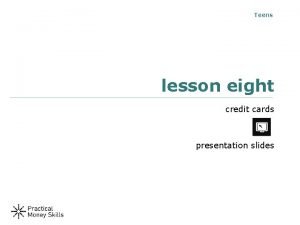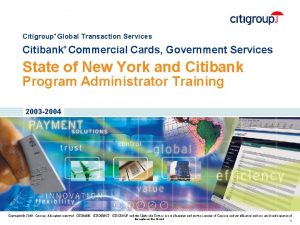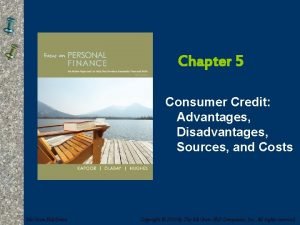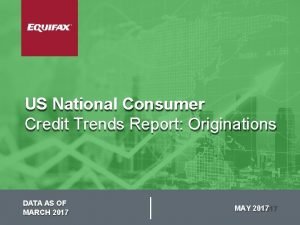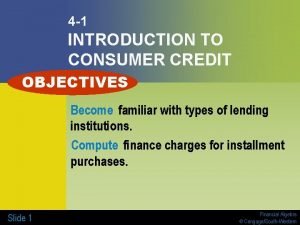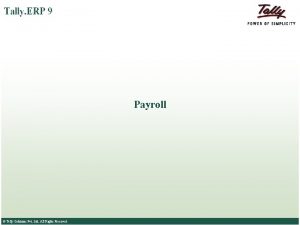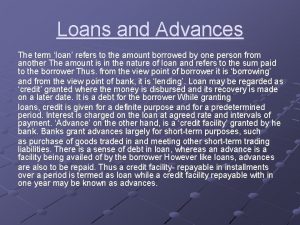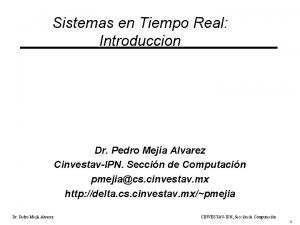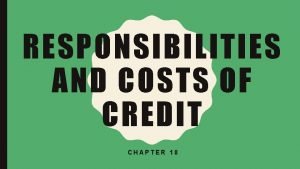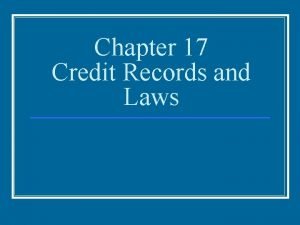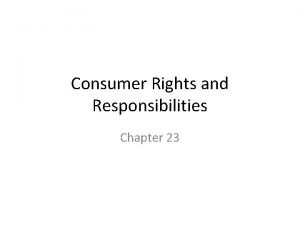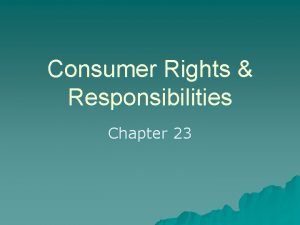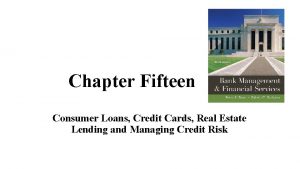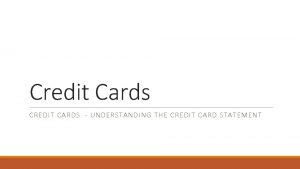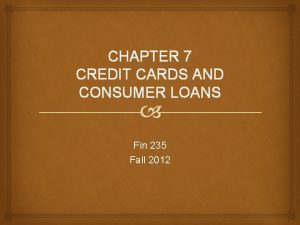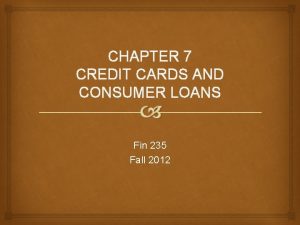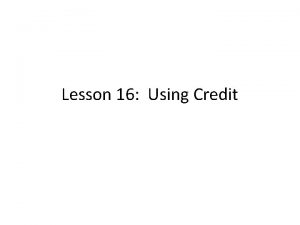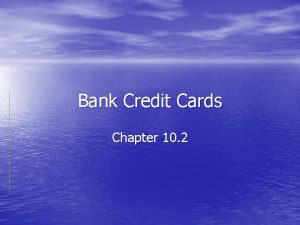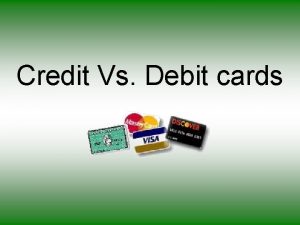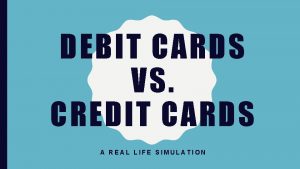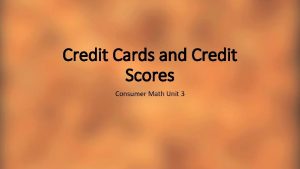Chapter Eighteen Consumer Loans Credit Cards and Real








































- Slides: 40

Chapter Eighteen Consumer Loans, Credit Cards, and Real Estate Lending Mc. Graw-Hill/Irwin Copyright © 2013 by The Mc. Graw-Hill Companies, Inc. All rights reserved.

Key Topics • Types of Loans for Individuals and Families • Unique Characteristics of Consumer Loans • Dodd-Frank, the Consumer Protection Bureau, and CARD • Evaluating a Consumer Loan Request • Credit Cards and Credit Scoring • Disclosure Rules and Discrimination • Consumer Loan Pricing and Refinancing Mc. Graw-Hill/Irwin Bank Management and Financial Services, 7/e © 2008 The Mc. Graw-Hill Companies, Inc. , All Rights Reserved. 18 -2

Introduction • Consumer debt has become one of the fastest growing forms of borrowing money ▫ Nearly $14 trillion in volume (including both mortgage and nonmortgage consumer debt) in the U. S. • The modern dominance of banks in lending to households stems from their growing reliance on individuals and families for their chief source of funds – checkable and savings deposits • Consumer credit is often among the most profitable services a lender can offer ▫ However, services directed at consumers can also be among the most costly and risky financial products Mc. Graw-Hill/Irwin Bank Management and Financial Services, 7/e © 2008 The Mc. Graw-Hill Companies, Inc. , All Rights Reserved. 18 -3

Types of Loans Granted to Individuals and Families • Consumer loans are classified by ▫ Purpose – what the borrowed funds will be used for ▫ Type – whether the borrower must repay in installments or repay in one lump sum • Residential Loans ▫ Credit to finance the purchase of a home or fund improvements on a private residence ▫ Usually a long-term loan, typically bearing a term of 15 to 30 years ▫ Secured by the property itself ▫ May carry either a fixed interest rate or a variable (floating) interest rate ▫ Banks are the leading residential mortgage lenders today Mc. Graw-Hill/Irwin Bank Management and Financial Services, 7/e © 2008 The Mc. Graw-Hill Companies, Inc. , All Rights Reserved. 18 -4

Types of Loans Granted to Individuals and Families (continued) • Nonresidential Loans ▫ Installment Loans ▫ Short-term to medium-term loans, repayable in two or more consecutive payments (usually monthly or quarterly) ▫ Used to buy big-ticket items (e. g. , automobiles, furniture, and home appliances) or to consolidate existing household debts ▫ Noninstallment Loans ▫ Short-term loans individuals and families draw upon for immediate cash needs that are repayable in a lump sum ▫ May be for relatively small amounts and include charge accounts that often require payment in 30 days or less ▫ May also be made for a short period (usually six months or less) to wealthier individuals and can be quite large Mc. Graw-Hill/Irwin Bank Management and Financial Services, 7/e © 2008 The Mc. Graw-Hill Companies, Inc. , All Rights Reserved. 18 -5

Types of Loans Granted to Individuals and Families (continued) • Credit Card Loans and Revolving Credit ▫ One of the most popular forms of consumer credit today is accessed via credit cards ▫ Credit cards offer their holders access to either installment or noninstallment credit ▫ Approximately two-thirds of all credit cards have variable rates of interest ▫ Installment users of credit cards are far more profitable due to the interest income they generate ▫ Card providers also earn discount fees (usually 1 to 7 percent of credit card sales) from merchants who accept their cards Mc. Graw-Hill/Irwin Bank Management and Financial Services, 7/e © 2008 The Mc. Graw-Hill Companies, Inc. , All Rights Reserved. 18 -6

Types of Loans Granted to Individuals and Families (continued) • New Credit Card Regulations ▫ New credit card regulations appeared early in 2003 to slow the expansion of card offers to customers with low credit ratings ▫ There was evidence that some customers were charged high fees but encouraged to make only low minimum payments ▫ Resulted in negative amortization ▫ Regulatory agencies warned lenders that federal examiners would begin looking for excessive use of fees and unreasonably liberal credit terms Mc. Graw-Hill/Irwin Bank Management and Financial Services, 7/e © 2008 The Mc. Graw-Hill Companies, Inc. , All Rights Reserved. 18 -7

Types of Loans Granted to Individuals and Families (continued) • New Consumer Regulations: Dodd-Frank, CARD Act, and the New Consumer Protection Bureau ▫ Tricks and Traps – The CARD Act and Revised Regulation Z Appear ▫ Despite the repeated efforts of credit card regulators to deal with problems in the credit card industry, consumer complaints continued ▫ Congress passed the Credit Card Accountability, Responsibility, and Disclosure Act (“CARD Act”) in May 2009 ▫ The new legislation restricted card issuers from raising Annual Percentage Rates (APRs) unless adequate written notice of a rate change was given Mc. Graw-Hill/Irwin Bank Management and Financial Services, 7/e © 2008 The Mc. Graw-Hill Companies, Inc. , All Rights Reserved. 18 -8

Types of Loans Granted to Individuals and Families (continued) • New Consumer Regulations: Dodd-Frank, CARD Act, and the New Consumer Protection Bureau ▫ Tricks and Traps – The CARD Act and Revised Regulation Z Appear ▫ Customers must be told the reasons why credit terms were being changed ▫ Card companies are required to post their contracts on the Internet so customers can “shop around” ▫ Card holders must receive periodic billing statements at least three weeks before monthly payments are due ▫ An expanded “box” must be included on each monthly billing statement, indicating the amount of interest paid and the consequences of paying the minimum amount ▫ Fall within the Federal Reserve Board’s Regulation Z Mc. Graw-Hill/Irwin Bank Management and Financial Services, 7/e © 2008 The Mc. Graw-Hill Companies, Inc. , All Rights Reserved. 18 -9

Types of Loans Granted to Individuals and Families (continued) • Dodd-Frank Reforms and Protections Push the Rules Farther Down the Road ▫ The Dodd-Frank Wall Street Reform and Consumer Protection Act ▫ Named after Senator Chris Dodd and Congressman Barney Frank ▫ Was signed into law by President Obama in July 2010 ▫ Creates the Consumer Financial Protection Bureau (CFPB) ▫ The new bureau is directed to write new rules applying to such financial services as: ▫ Making of consumer and credit card loans ▫ Warning consumers of possible damaging financial practices that could result in losses ▫ Promoting financial literacy among consumers ▫ Improving the clarity and transparency of financial-service contracts for the benefit of the public Mc. Graw-Hill/Irwin Bank Management and Financial Services, 7/e © 2008 The Mc. Graw-Hill Companies, Inc. , All Rights Reserved. 18 -10

Types of Loans Granted to Individuals and Families (continued) • Dodd-Frank Reforms and Protections Push the Rules Farther Down the Road ▫ The Dodd-Frank Wall Street Reform and Consumer Protection Act ▫ The new CFPB is to be housed within the Federal Reserve but operate independently with its own budget ▫ The consumer protection bureau is expected to be controversial because it must write hundreds of rules that will likely impact the consumer services side of financialservice providers Mc. Graw-Hill/Irwin Bank Management and Financial Services, 7/e © 2008 The Mc. Graw-Hill Companies, Inc. , All Rights Reserved. 18 -11

Characteristics of Consumer Loans • Lenders regard consumer loans as profitable credits with “sticky” interest rates ▫ Contract interest rates often do not change readily with market conditions as do interest rates on most business loans ▫ As a result, many consumer loans are subject to significant interest rate risk • Consumer loans are usually priced so high that market interest rates on borrowed funds and default rates on the loans themselves would have to rise substantially before consumer credits would become unprofitable Mc. Graw-Hill/Irwin Bank Management and Financial Services, 7/e © 2008 The Mc. Graw-Hill Companies, Inc. , All Rights Reserved. 18 -12

Characteristics of Consumer Loans (continued) • Why are interest rates so high on most consumer loans? ▫ Consumer loans are among the most costly and most risky to make per dollar of loanable funds committed to them ▫ Consumer loans tend to be cyclically sensitive ▫ Household borrowings appear to relatively interest inelastic ▫ They are more concerned about the size of the monthly payment rather than the interest rate that they are charged ▫ Education and income levels materially influence consumers’ use of credit Mc. Graw-Hill/Irwin Bank Management and Financial Services, 7/e © 2008 The Mc. Graw-Hill Companies, Inc. , All Rights Reserved. 18 -13

Evaluating a Consumer Loan Application • Character and Purpose ▫ Key factors in analyzing any consumer loan application are the character of the borrower and the borrower’s ability to pay ▫ Consumer lenders nearly always check with one or more credit bureaus concerning the customer’s credit history ▫ In the case of a borrower without a credit record or with a poor track record of repaying loans, a cosigner may be requested to support repayment ▫ Many lenders regard a cosigner as primarily a psychological device to encourage repayment of the loan Mc. Graw-Hill/Irwin Bank Management and Financial Services, 7/e © 2008 The Mc. Graw-Hill Companies, Inc. , All Rights Reserved. 18 -14

Evaluating a Consumer Loan Application (continued) • Other Important Items For Lenders ▫ Income Levels ▫ Deposit Balances ▫ Employment and Residential Stability ▫ Pyramiding of Debt • How to Qualify for a Consumer Loan ▫ Home ownership or ownership of any form of real property ▫ Maintain strong deposit balances ▫ The most important thing to do – truthfully answer all of the loan officer’s questions Mc. Graw-Hill/Irwin Bank Management and Financial Services, 7/e © 2008 The Mc. Graw-Hill Companies, Inc. , All Rights Reserved. 18 -15

Credit Scoring Consumer Loan Application • The basic theory of credit scoring is that lenders and statisticians can identify the financial, economic, and motivational factors that separate good loans from bad loans • Underlying assumption – the same factors that separated good loans from bad loans in the past will separate good loans from bad ones in the future within an acceptable risk of error • Such an automated credit determining system removes personal judgment from the lending process Mc. Graw-Hill/Irwin Bank Management and Financial Services, 7/e © 2008 The Mc. Graw-Hill Companies, Inc. , All Rights Reserved. 18 -16

Credit Scoring Consumer Loan Application (continued) • The FICO System ▫ Developed by the Fair Isaac Corporation ▫ Most famous of all credit-scoring systems currently in use ▫ Scores range from 300 to 850 with higher values denoting less credit risk to lenders ▫ FICO score are based on five different types of information (most important to least important): 1. 2. 3. 4. 5. The borrower’s payment history The amount of money owed The length of a prospective borrower’s credit history The nature of new credit being requested The types of credit that the borrower has already used Mc. Graw-Hill/Irwin Bank Management and Financial Services, 7/e © 2008 The Mc. Graw-Hill Companies, Inc. , All Rights Reserved. 18 -17

Laws and Regulations Applying to Consumer Loans • Numerous laws and regulations limiting the activities of consumer lending institutions have been enacted • These laws fall into two categories: 1. Disclosure rules ▫ Mandate telling the consumer about the cost and other terms of a loan or lease agreement 2. Antidiscrimination laws ▫ Prevent categorizing loan customers according to their age, sex, race, or other irrelevant factors and denying credit to anyone solely because of membership in one or more of these groups Mc. Graw-Hill/Irwin Bank Management and Financial Services, 7/e © 2008 The Mc. Graw-Hill Companies, Inc. , All Rights Reserved. 18 -18

Laws and Regulations Applying to Consumer Loans (continued) • Customer Disclosure Requirements ▫ ▫ Truth-in-Lending Act Fair Credit Reporting Act Fair Credit Billing Act Fair Debt Collection Practices Act • Outlawing Credit Discrimination ▫ Equal Credit Opportunity Act ▫ Community Reinvestment Act Mc. Graw-Hill/Irwin Bank Management and Financial Services, 7/e © 2008 The Mc. Graw-Hill Companies, Inc. , All Rights Reserved. 18 -19

Laws and Regulations Applying to Consumer Loans (continued) • Predatory lending ▫ An abusive practice among some lenders where lenders may require excessive fees as well as unnecessary and excessive loan insurance • Subprime Loans ▫ Granting loans to borrowers who have below-average credit scores • The Home Ownership and Equity Protection Act was passed in 1994 to protect home buyers from loan agreements they could not afford • Subprime lending is difficult to regulate Mc. Graw-Hill/Irwin Bank Management and Financial Services, 7/e © 2008 The Mc. Graw-Hill Companies, Inc. , All Rights Reserved. 18 -20

Real Estate Loans • Depository institutions and finance and insurance companies make real estate loans to fund the acquisition of real property ▫ Homes, apartment complexes, shopping centers, office buildings, and land • One of the most rapidly growing areas of lending over the past decade • Real estate lending is different from other loans • Real estate loans can be among the riskiest forms of credit extended to customers Mc. Graw-Hill/Irwin Bank Management and Financial Services, 7/e © 2008 The Mc. Graw-Hill Companies, Inc. , All Rights Reserved. 18 -21

Real Estate Loans (continued) • Differences between Real Estate Loans and Other Loans ▫ The average size of a real estate loan is usually much larger than the average size of other loans ▫ Mortgage loans tend to have longer maturities versus other types of loans ▫ Maturities of 15 years to 30 years are typical for singlefamily homes ▫ With real estate lending, the condition and value of the subject property are nearly as important as the borrower’s income ▫ Appraisals are critical to the loan decision and must meet industry standards and government regulations Mc. Graw-Hill/Irwin Bank Management and Financial Services, 7/e © 2008 The Mc. Graw-Hill Companies, Inc. , All Rights Reserved. 18 -22

Real Estate Loans (continued) • Factors in Evaluating Applications for Real Estate Loans ▫ The amount of the down payment pledged by the borrower relative to the purchase price of mortgaged property ▫ The higher the ratio of loan amount to purchase price, the less incentive the borrower has to honor the terms of the loan ▫ Lenders may be willing to give a mortgage loan customer a lower loan rate for a pledge that the customer will use the lender’s other financial services Mc. Graw-Hill/Irwin Bank Management and Financial Services, 7/e © 2008 The Mc. Graw-Hill Companies, Inc. , All Rights Reserved. 18 -23

Real Estate Loans (continued) • Factors in Evaluating Applications for Real Estate Loans ▫ Other aspects of each credit application that require assessment: ▫ Amount and stability of the borrower’s income ▫ The borrower’s available savings and where the borrower will obtain the required down payment ▫ The borrower’s track record in caring for and managing property ▫ The outlook for real estate sales in the local market in case of repossession of the property ▫ The outlook for market interest rates Mc. Graw-Hill/Irwin Bank Management and Financial Services, 7/e © 2008 The Mc. Graw-Hill Companies, Inc. , All Rights Reserved. 18 -24

Real Estate Loans (continued) • Home Equity Lending ▫ Homeowners can borrow the equity in their homes ▫ Equity is defined as the difference between a home’s estimated market value and the amount of the mortgage loans against it ▫ Two main types of home equity loans: 1. Traditional Home Equity Loan 2. Lines of Credit Against a Home’s Borrowing Base Mc. Graw-Hill/Irwin Bank Management and Financial Services, 7/e © 2008 The Mc. Graw-Hill Companies, Inc. , All Rights Reserved. 18 -25

Real Estate Loans (continued) • The Most Controversial of Home Mortgage Loans: Interest-Only and Adjustable Mortgages and the Recent Mortgage Crisis ▫ When housing prices were soaring upward during the recent housing boom, how could lenders make extravagantly priced homes affordable? ▫ Make home mortgage loans more readily available to families of even modest means ▫ More families were encouraged to sign up for adjustable-rate loans (ARMs) during a period when market interest rates were at historic lows Mc. Graw-Hill/Irwin Bank Management and Financial Services, 7/e © 2008 The Mc. Graw-Hill Companies, Inc. , All Rights Reserved. 18 -26

Real Estate Loans (continued) • The Most Controversial of Home Mortgage Loans: Interest. Only and Adjustable Mortgages and the Recent Mortgage Crisis ▫ When home prices continued to rise, clever mortgage lenders came up with yet another financial innovation – the interestonly adjustable home mortgage loan (option ARM) ▫ With this type of credit the home buyer is obligated to pay only the interest on his or her home loan for an initial period ▫ After that initial time interval passes, the home buyer would have to pay both principal and interest until the loan was finally paid off ▫ Looked like predatory lending against lower-income families ▫ In an environment of rising market interest rates, many home buyers with adjustable-rate loans faced higher interest payments Mc. Graw-Hill/Irwin Bank Management and Financial Services, 7/e © 2008 The Mc. Graw-Hill Companies, Inc. , All Rights Reserved. 18 -27

Real Estate Loans (continued) • The Most Controversial of Home Mortgage Loans: Interest. Only and Adjustable Mortgages and the Recent Mortgage Crisis ▫ Now lenders must disclose more about the actual terms of a home mortgage loan and not represent a loan’s terms as “fixed” when those terms can be changed over time ▫ Dodd-Frank Wall Street Reform and Consumer Protection Act resulted in tough new rules ▫ Lenders who are pooling and securitizing mortgage loans they create and sell are responsible for at least 5 percent of the credit risk attached (qualified mortgages are exempt) ▫ Previously lenders “washed their hands” of any responsibility Mc. Graw-Hill/Irwin Bank Management and Financial Services, 7/e © 2008 The Mc. Graw-Hill Companies, Inc. , All Rights Reserved. 18 -28

A Revised Federal Bankruptcy Code as Bankruptcy Filings Soar • Households in record numbers have sought protection from their creditors under the U. S. bankruptcy code • Bankruptcy Abuse Prevention and Consumer Protection Act ▫ Signed in April 2005 by President George W. Bush ▫ Made filing for bankruptcy more expensive and timeconsuming ▫ Before filing for bankruptcy, applicants must complete a certified credit counseling program ▫ Intended to discourage consumers from taking on too much debt and increasing their risk profile Mc. Graw-Hill/Irwin Bank Management and Financial Services, 7/e © 2008 The Mc. Graw-Hill Companies, Inc. , All Rights Reserved. 18 -29

A Revised Federal Bankruptcy Code as Bankruptcy Filings Soar (continued) • A means test determines whether an applicant must file under Chapter 7 or Chapter 13 of the bankruptcy code ▫ Means Test - an average of a debtor’s past six months of gross income ▫ Test determines if the debtor has enough income to pay some of the debt • Under the previous bankruptcy code, most individuals filed for Chapter 7 ▫ Wiped out all or most debts and generally allowed for a fresh start • Makes it harder for applicants to apply for Chapter 7 ▫ More applicants, as a result must file under Chapter 13 ▫ Stipulates that at least some debts must be repaid Mc. Graw-Hill/Irwin Bank Management and Financial Services, 7/e © 2008 The Mc. Graw-Hill Companies, Inc. , All Rights Reserved. 18 -30

Pricing Consumer and Real Estate Loans: Determining the Rate of Interest and Other Loan Terms • A financial institution prices every consumer loan by setting an interest rate, maturity, and terms of repayment • The Interest Rate Attached to Nonresidential Consumer Loans ▫ The Cost-Plus Model Mc. Graw-Hill/Irwin Bank Management and Financial Services, 7/e © 2008 The Mc. Graw-Hill Companies, Inc. , All Rights Reserved. 18 -31

Pricing Consumer and Real Estate Loans: Determining the Rate of Interest and Other Loan Terms (continued) • Annual Percentage Rate (APR) ▫ Annualized internal rate of return that equates expected total payments with the amount of the loan ▫ Takes into account how fast the loan is being repaid and how much credit the customer will actually have use of during the life of the loan ▫ Under the Truth-in-Lending Act, lenders must give the household borrower a statement specifying the APR ▫ Allows borrowers to compare a particular loan rate with the loan rates of other lenders Mc. Graw-Hill/Irwin Bank Management and Financial Services, 7/e © 2008 The Mc. Graw-Hill Companies, Inc. , All Rights Reserved. 18 -32

Pricing Consumer and Real Estate Loans: Determining the Rate of Interest and Other Loan Terms (continued) • Simple Interest Rate ▫ Adjusts for the length of time a borrower actually has use of credit ▫ If the customer is paying off the loan gradually, this approach determines the declining loan balance, and that reduced balance is then used to determine the amount of interest owed Mc. Graw-Hill/Irwin Bank Management and Financial Services, 7/e © 2008 The Mc. Graw-Hill Companies, Inc. , All Rights Reserved. 18 -33

Pricing Consumer and Real Estate Loans: Determining the Rate of Interest and Other Loan Terms (continued) • The Discount Rate Method ▫ Requires the customer to pay interest up front ▫ Interest is deducted first and the customer receives the loan amount less any interest owed • The Add-On Loan Rate Method ▫ One of the oldest loan rate calculation methods ▫ Any interest owed is added to the principal amount of the loan before calculating required installment payments ▫ Only if the loan is paid off in a single lump sum at the end will the add-on rate equal the simple interest rate Mc. Graw-Hill/Irwin Bank Management and Financial Services, 7/e © 2008 The Mc. Graw-Hill Companies, Inc. , All Rights Reserved. 18 -34

Pricing Consumer and Real Estate Loans: Determining the Rate of Interest and Other Loan Terms (continued) • Rule of 78 s ▫ A rule of thumb to determine how much interest income a lender is entitled to accrue at any point in time from a loan that is being paid out in monthly installments ▫ Important especially when a borrower wants to pay off a loan early ▫ Rule arises from the fact that the sum of the digits 1 through 12 is 78 ▫ To determine the borrowing customer’s interest rebate from early repayment of an installment loan, total the digits for the months remaining on the loan and divide the sum by 78 Mc. Graw-Hill/Irwin Bank Management and Financial Services, 7/e © 2008 The Mc. Graw-Hill Companies, Inc. , All Rights Reserved. 18 -35

Pricing Consumer and Real Estate Loans: Determining the Rate of Interest and Other Loan Terms (continued) • Rule of 78 s ▫ Example ▫ A customer requests a one-year loan to be repaid in 12 monthly installments ▫ Customer would also like to repay the loan after only nine months ▫ Interest rebate that the customer is entitled to receive back ▫ The lender is entitled to keep 92. 31 percent of the finance charges Mc. Graw-Hill/Irwin Bank Management and Financial Services, 7/e © 2008 The Mc. Graw-Hill Companies, Inc. , All Rights Reserved. 18 -36

Pricing Consumer and Real Estate Loans: Determining the Rate of Interest and Other Loan Terms (continued) • Interest Rates on Home Mortgage Loans ▫ Since the 1930 s, most loans to finance the purchase of new homes were fixed-rate mortgages (FRMs) ▫ In 1981, adjustable-rate mortgages (ARMs) were authorized for offering by all federally chartered depository institutions ▫ Created in response to the pressure of inflation and volatile interest rates Mc. Graw-Hill/Irwin Bank Management and Financial Services, 7/e © 2008 The Mc. Graw-Hill Companies, Inc. , All Rights Reserved. 18 -37

Pricing Consumer and Real Estate Loans: Determining the Rate of Interest and Other Loan Terms (continued) • Interest Rates on Home Mortgage Loans ▫ Whether a customer takes out a FRM or ARM, the loan officer must determine what the initial loan rate will be and what the monthly payments will be ▫ The formula to compute monthly mortgage payments is Mc. Graw-Hill/Irwin Bank Management and Financial Services, 7/e © 2008 The Mc. Graw-Hill Companies, Inc. , All Rights Reserved. 18 -38

Pricing Consumer and Real Estate Loans: Determining the Rate of Interest and Other Loan Terms (continued) • Charging the Customer Mortgage Points ▫ Home mortgage loan agreements often require borrowers to pay an additional charge up front called points ▫ Points are prepaid interest and may be deductible as home mortgage interest ▫ For example, suppose the borrower seeks a $100, 000 home loan and the lender assesses the borrower an up-front charge of two points Mc. Graw-Hill/Irwin Bank Management and Financial Services, 7/e © 2008 The Mc. Graw-Hill Companies, Inc. , All Rights Reserved. 18 -39

Quick Quiz • What are the principal differences among residential loans, nonresidential installment loans, noninstallment loans, and credit card or revolving loans? • What are the principal advantages to a lending institution of using a credit-scoring system? Are there any significant disadvantages to a credit-scoring system? • What laws exist today to give consumers fuller disclosure about the terms and risks of taking on credit? • What is home equity lending, and what are its advantages and disadvantages for banks and other consumer lending institutions? • What options does a loan officer have in pricing consumer loans? • How is the loan rate figured on a home mortgage loan? What are the key factors or variables? Mc. Graw-Hill/Irwin Bank Management and Financial Services, 7/e © 2008 The Mc. Graw-Hill Companies, Inc. , All Rights Reserved. 18 -40
 Food web and food chain difference
Food web and food chain difference Source note cards
Source note cards Great gatsby lessons
Great gatsby lessons Eighteen month old becca is in the telegraphic speech phase
Eighteen month old becca is in the telegraphic speech phase Lesson eight credit cards
Lesson eight credit cards Advantages of debit card
Advantages of debit card Credit card 101
Credit card 101 4-4 credit cards worksheet answers
4-4 credit cards worksheet answers 3 6 credit card statement
3 6 credit card statement Lamination plates for credit cards
Lamination plates for credit cards Citidirect commercial cards
Citidirect commercial cards Conclusion of credit card
Conclusion of credit card Disadvantages of consumer credit
Disadvantages of consumer credit Consumer markets and consumer buyer behavior
Consumer markets and consumer buyer behavior Consumer markets and consumer buyer behavior
Consumer markets and consumer buyer behavior Loan vocabulary
Loan vocabulary This can be avoided by giving credit where credit is due.
This can be avoided by giving credit where credit is due. Equifax national consumer credit trends report
Equifax national consumer credit trends report Monique buys a $4 700 air conditioning
Monique buys a $4 700 air conditioning 3-1 introduction to consumer credit
3-1 introduction to consumer credit Consumer credit of the quad cities
Consumer credit of the quad cities Primary consumer
Primary consumer Cengage
Cengage Consumer behaviour research process
Consumer behaviour research process Payroll in tally erp 9
Payroll in tally erp 9 Short term loans and advances
Short term loans and advances Sensor and (tiempo real or real time)
Sensor and (tiempo real or real time) Chapter 18 responsibilities and costs of credit
Chapter 18 responsibilities and costs of credit Chapter 9 obtaining and protecting your credit
Chapter 9 obtaining and protecting your credit Chapter 9 credit problems and laws
Chapter 9 credit problems and laws Chapter 26 how to get and keep credit worksheet answers
Chapter 26 how to get and keep credit worksheet answers Chapter 17 credit records and laws
Chapter 17 credit records and laws Chapter 9 obtaining and protecting your credit
Chapter 9 obtaining and protecting your credit Responsibilities of a consumer
Responsibilities of a consumer The right to have problems corrected
The right to have problems corrected Chapter 1 consumer powers and protections
Chapter 1 consumer powers and protections Chapter 5 consumer markets and buyer behavior
Chapter 5 consumer markets and buyer behavior Chapter 23 consumer rights and responsibilities
Chapter 23 consumer rights and responsibilities Chapter 6 consumer purchasing and protection
Chapter 6 consumer purchasing and protection Sla servicing student loans
Sla servicing student loans Pricing business loans
Pricing business loans




